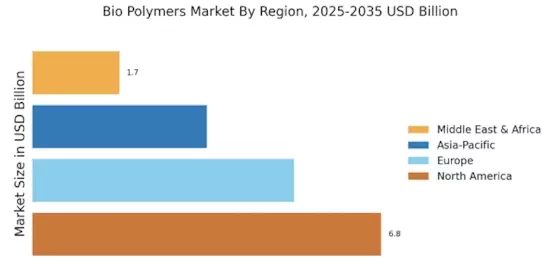Regulatory Support
Regulatory frameworks are increasingly favoring the adoption of bio-based materials, thereby driving the Bio Polymers Market. Governments worldwide are implementing policies that promote the use of sustainable materials, including incentives for companies that utilize bio-based polymers. For example, the European Union has set ambitious targets for reducing plastic waste, which has led to a surge in demand for biodegradable alternatives. This regulatory support is expected to bolster the market, with estimates suggesting that the bio-based polymer segment could capture a market share of over 25% by 2030. Such policies not only encourage innovation within the Bio Polymers Market but also create a conducive environment for investment in sustainable technologies.
Diverse Application Areas
The versatility of bio-based polymers is driving their adoption across a multitude of sectors, thereby propelling the Bio Polymers Market. These materials are being utilized in packaging, agriculture, automotive, and medical applications, among others. The packaging sector, in particular, is witnessing a notable shift, with bio-based films and containers gaining popularity due to their biodegradability and reduced carbon footprint. Market analysts project that the packaging segment alone could account for over 40% of the total bio-based polymer market by 2026. This diverse applicability not only enhances the market's growth potential but also underscores the adaptability of bio-based materials in meeting the specific needs of various industries, further solidifying the Bio Polymers Market's position in the materials landscape.
Technological Innovations
Technological advancements are playing a crucial role in shaping the Bio Polymers Market. Innovations in polymerization techniques and material processing are enabling the development of high-performance bio-based polymers. For instance, advancements in fermentation technology have led to the production of polylactic acid (PLA) from renewable resources, which is gaining traction in various applications, including packaging and textiles. The market is expected to witness a significant increase in the adoption of these technologies, with projections indicating a potential market size of USD 10 billion by 2027. This growth is indicative of the Bio Polymers Market's ability to adapt and evolve, driven by continuous research and development efforts aimed at enhancing the properties and applications of bio-based materials.
Sustainability Initiatives
The increasing emphasis on sustainability appears to be a primary driver for the Bio Polymers Market. As consumers and businesses alike become more environmentally conscious, the demand for biodegradable and renewable materials is surging. This shift is reflected in the market, where the bio-based polymer segment is projected to grow at a compound annual growth rate of approximately 12% over the next five years. Companies are investing in sustainable practices, which not only enhance their brand image but also align with regulatory frameworks aimed at reducing plastic waste. The Bio Polymers Market is thus witnessing a transformation, as traditional petroleum-based plastics are gradually being replaced by bio-based alternatives that offer similar performance characteristics while minimizing environmental impact.
Consumer Demand for Eco-Friendly Products
The rising consumer demand for eco-friendly products is significantly influencing the Bio Polymers Market. As awareness of environmental issues grows, consumers are increasingly seeking products that are not only functional but also sustainable. This trend is evident in various sectors, including packaging, automotive, and consumer goods, where companies are responding by incorporating bio-based materials into their offerings. Market Research Future indicates that nearly 70% of consumers are willing to pay a premium for sustainable products, which is prompting manufacturers to explore bio-based alternatives. Consequently, the Bio Polymers Market is experiencing a paradigm shift, as businesses strive to meet consumer expectations while adhering to sustainability goals.


















Leave a Comment